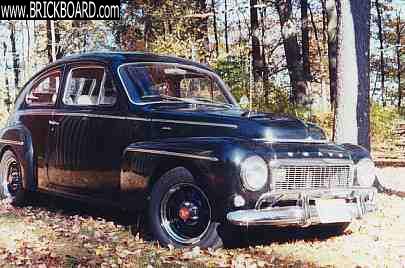
|
|
Hello All:
1967 122S Wagon. I have owned her for about two months. Believe it or not, this is the first car I have ever owned.
Yes, I live in New York.
I want to get her ready for her first winter in the Northeast. I would love input on the following subjects but first and foremost, my wife reports that she has to press the clutch nearly to the floor to engage reverse, third and I believe second gears. She thinks the clutch master cylinder probably needs topping off and I also thought that maybe some air got in the line. I am going to bleed it out this weekend. What should I use for clutch fluid?
Now for the winterizing. Here is my checklist. Please add/subtract/edit:
-Coolant: Which brand? What percentage mix of water to coolant? What is the best procedure for draining and refilling?
-Oil: Again, which brand, including filter?
-Air Filter (dual SUs): Which brand?
-Diff: Fluid was recently topped off (2,000 miles ago). Safe to skip?
-Car Cover: Sadly, Virginia will be living outside. I saw a previous post regarding car covers. Hopefully Beverly Hills has one for a wagon.
-Snow tires: Any recommendations? Where is the best place to buy tires these days?
-Underbody treatment: This is a problem. The only shortcoming of the car is that water got inside and sat for quite a while, rusting out the floor from the inside out. Just a few pinholes now but next year's big project is putting in a new floor. In the meanwhile I would like to treat the bottom of the car. Any suggestions?
Cheers,
Jeff Pucillo
|
|

|
|
CONGRATULATIONS, I am the new owner of Patricks old 122 and yes the floor is great. As for the break and clutch fluid DO NOT USE DOT 5 ! In the past I used dot 5 in a car specifying dot 4, it worked well for a while but after 16 months of use all the rubber turned to mush(not over-night but a slow decline)leading to leaks and poor performance. I would suggest dot 4 for the breaks and clutch(though not required in the clutch, but saves the need to buy 2 types). Since you don't know the maintenance of the P.O. it would be advisable to flush out all the old break and clutch fluid, a good maintenance proceedure every 2 years. As for winterizing I would like to add a check and lube of the breaks and wheel bearings, check that the heater hoses are in good shape and before adding new coolent do a flush. When the new coolent is added also add a stop leak/pump lubricant to the system as a saftey pre-caution. And the best advice I can give you to kepp it for a long time(as we are want to do with a 122) is to by a beater 240 or 740 for the winter, they are available , cheap, safe, warm, and parts are more readily available. If you are close to the Quebec border I can sell you old faith-full for a reasonable cost($400.00 cdn). Its a nice 81 242 that starts on command even in the coldest of cold spells, and I have no more use for the car, but want it to go to a good volvo home.
--
65 122, 73 P1800ES, 79 242GT, 80 262C, 81 242, 87 780,88 745T X2, and a plethora of parts cars and eventually to be finished projects
|
|
|
|
|
Glad you're enjoying Nero Augustus, great tight car. I did drive it through a couple of winters, but would'nt do it again, except they do handle great in the snow! I agree a cheap 240/740 etc is the best way to winterize a 120.
|
|

|
|
Patrick, could you please explain the origin of the name "nero augustus" for the 122? And don't worry winter will be spent in a nice heated warehouse(with 70 or so other cars, including all but my 2 745t's) for the rest of it's days(I expect to live another 30 years, statisticly speaking, so it stands to reason so will it. For your info we have baptized it 'ti rouge, after the radio caracter on 94.3, a person on BS(french for social assistance) who won't get a job, to compliment the wonderfull roller and brush paint job, and it's original colour. I might be painting it this winter if I have the time, if not next winter for sure. I hope you enjoyed the car as much as I? BTW how's the wagon?
Merci
Yvan
--
65 122, 73 P1800ES, 79 242GT, 80 262C, 81 242, 87 780,88 745T X2, and a plethora of parts cars and eventually to be finished projects
|
|
|
|
|
Nero because it's black and Augustus because I put it together in August. And Nero Augustus because it sounds emperial. I don't think there was a Nero Augustus, but I'm not sure because the romans used to string about twenty names including those of their predesors into one title. I'm getting the wagon ready for it's paint job this spring, cars is tight and I will enjoy using it as a sales vehicle when I go out to do estimates etc... Happy thanksgiving, Patrick.
|
|
|
|
|
tires: the old beetle uses the same size tires. Sometimes when you are looking around it helps to ask for the tires for a early seveties beetle. Anyway 165/65 R15, 185/65 R15, actaually the thinner the better for good snow handling. When i still ran my 120 in the winter i would buy used winter tires, use the phone you will be surprised the deals you can find. Also when it is very cold out the car shifts slowly when the tranny is cold, the first few minutes you have to get the shift just right, and I often skip 2nd as it is too hard to engage, I'm pretty sure this is jsut the oil being very thick at first. As far as oil spray undercoating get whatever is on the market and if you really care about the car and drive it in the winter, give it a good wash underneath next spring and oil spray it again. For undercaoting itself i use wet stick roof repair tar, has about the same consitency as the original product. For hard to reach places I buy a can of the sprayable tar for car underbodies.
|
|
posted by
someone claiming to be volvolio
on
Fri Oct 8 15:57 CST 2004 [ RELATED]
|
|
Is there some kind of handy technique for getting under a 122 and "giving it a good washing"? I don't have access to a lift of any sort, so the best I can do is maybe jacking it up hight on one side I guess...?
|
|

|
|
Hello Volvolio:
I just had to climb under the brick today to do the clutch fluid transfusion. Method? Two metal ramps, found in my basement, left by the previous tenant(lucky me). Just drive up on 'em. They can be purchased at any auto supply store, I do not know how much, but an investment that is worth its weight in gold.
Just remember to chock the back wheels with a brick or sturdy 4x4.
Cheers,
Jeff Pucillo
|
|
posted by
someone claiming to be volvolio
on
Mon Oct 11 06:41 CST 2004 [ RELATED]
|
|
I happen to have a set of ramps myself, so thanks for the idea. I had always thought of those as just two wheels front or back, not two on one side.
|
|

|
|
Jeff,
Just a little very important thing:
ALWAYS use an original oilfilter! Why? -because the original oilfilter from Volvo is with a valve (?) so that the oil doesn't run all back in the resovoir. Hope you get my english..
Un-original (and cheap) oilfilters doesn't have that valve - which then leads to many engine -turns before oil is pumped all the way up and around the canals..
Good luck with your new Volvo !
Cheers,
Soren
|
|
|
|
|
I agree... note that Volvo filters are Mann filters with a different paint job -- they are exactly the same thing.
|
|

|
|
Before you put in the tar paper and once you have the floor exposed and clean as possible. Try using Pour 15 ( I think that is the name of it) IT converts rust into a primer base and will hopefully stop the rust and seal it before covering it up. Allow time for it to dry completly before covering it up. It is a brush on paint and is very tough, made for coating rusty areas. Check with a local auto parts that handles automotive paint and they can advise you as to where to get it.
It works great to stop existing rust if you are not ready to replace panels at this time.
Dennis
|
|

|
|
If you are in an area where there are marine supply stores, buy a quart of Pettit's Rust-Lok Metal Primer. Seems like pretty much the same stuff as POR-15 for a lot less money. Coal-tar epoxy , sold as Z-Spar's Poxitar at marine supply stores, over the Rust-Lok makes for a good suspenders-and-belt system. I've also been using Zero-Rust, which seems to work just as well as POR-15 or Rust-Lok, costs about the same as Rust Lok, but has a longer pot-life. So you waste less. Two-part epoxy putty, from POR-15 or the Home Depot On Line Store, works well on pin holes; so does the very thin fiberglass matt that POR-15 sells (ipd also carries their products), but I haven't found another source for the fiberglass. You first treat the rusted area with POR-15 or Rust-Lok, let the final coat get tacky, lay down the fiberglass, and then daub on several coats of POR-15 or Rust-Lok. If you then apply Patrick's roofing tar and George's rooffing felt over that , the floor should last for a while. Nothing, of course, beats welding in new sheet metal.
Bob S.
|
|
|
|
|
I agree with TomTom on the fluid. Drain it all and then refill with
DOT5. I have not actually had to bleed but it took a while before it
completely self-bled.
One gallon of brand-name commercial anti-freeze will be plenty. Be sure to
drain it from everywhere (block drain above and behind oil filter) then
put in the gallon of anti-freeze through the radiator cap, top off with
water with the heater turned on. As you run the engine the level will probably
drop some as you purge the air out of the system.
Some guys push synthetic oil. They last forever with much cheaper regular oil,
so I see little benefit. I would use a good brand, by an oil company, not a
specialty company. I use Phillips TropArtic. Texaco, Chevron, Mobil and
others make good oil also.
If your floor is not too thin (VERY common problem) you might consider
spraying undercoating on the floor and covering it with tarpaper ("building
felt"). I have part of a roll of which I would send you enough to do your
floors for the shipping. Left over from my last roof and couldn't bear to
throw it away. Should also spray the undercoat on the underside if it is not
already undercoated. Resealing the windshield will help keep recurrence down.
--
George Downs, Bartlesville, Oklahoma, Central US
|
|
posted by
someone claiming to be TomTom
on
Fri Oct 8 04:57 CST 2004 [ RELATED]
|
|
Congratulations on your new car.
When my clutch slave cylinder failed this summer I renewed it and took the option of going over to silicone fluid. There has been quite a lot of debate over the DOTs and silicone - check the archives. Personally I am hoping that the non-hygroscopic fluid will prolong the life of the master/slave and not need topping up for AGES. And it's a lovely purple colour. The clutch feels a tad heavier, but then again it was probably too soft before with the failing slave.
Tom
|
|

|
|
Silicone fluid is not only of the best - a lot of old-type rubber seal and so does NOT work together with silicone and the silicone eats the rubber. I would check my master/slave pistons-rubbersealings (Tom!).. And wouldn't be too sure that it really works.. Maybe your a little "heavier" pedal is due to more "resistance" in the pistons both master/slave due to silicone/rubber-mix.
In the clucth-system it has absolutely no meaning using silicone-based fluid - the fluid is in no (?) way exposed to high temp.s! (I guess not even in a typical morning-traffic into N.Y city.. :-) )
-and silicone fluid is also mostly too avoid water-bindings in the normal brake-fluid..-which again has to do with heating when braking and rusting the brakecylinders from inside - the clucth-system is all aluminium..
"Over-doing" is not always a benefit..
Use regular brake-fluid! -is my opinion.. :-)
Hope my english come out understandable and that Tom doesn't feel stepped on..
/Soren
|
|
posted by
someone claiming to be TomTom
on
Sun Oct 10 10:22 CST 2004 [ RELATED]
|
|
Thanks for the tip on checking the rubber components, Soren. I don't feel stepped on at all since my decision to change to DOT 5 was partly based on opinion and evidence of several seasoned (I use that in the nicest way) members of this board who have had good results Thanks for the heads-up George).
I am under the impression that older DOT 5s did have some issues with damaging rubber but that these were 'solved' in later versions. Did you have this trouble with old rubber and older silicone? If my seals are newer then perhaps they will be more resistant?
If I find that the rubber is getting damaged faster than just wear and tear then I shall hold my hands up and consider changing back. That's the great thing about old cars; they make you quite philosphical (except about emergency braking on the motorway, then you're back to regular cursing!).
Tom
|
|

|
|
Tom,
I agree!... They make us philosophical - or at least thinking about solutions, problems, "how-too-do's" and the like everytime we are stock due to other life-living things like being bound to the toilet, in bath, waiting for dinner, having s.. ??.. Ehh.. or is it just me??.. (couldn't help it.. Hopefully my humor is ok..)
Anyway, I can't say that I'm an expert, but I think like this: The fluid and the rubber "live" together and therefor philosophicaly got to also "work" together! -the fluid has a job: -to transport the force/pressure from the pedal to the clucth, the rubber sealing at the piston has a job: -to seal the piston in the master/slavecylinder so that full pressure gets transported..
If the fluid is "thinner" than the tolerence the rubberseal gives - there is a problem - if the rubber doesn't stay "sharp" at doing it's job, the fluid again wins..
Anyway, both components are chemical, and todays rubber is often filled with carbon (to make it cheaper) - silicone is also chemistry - and a "modern" invention - What I'm trying to say is, that the chemistry of them modern components both are filled with all sorts of other chemicals -to make it easy to fabricate, to not eat the container, to make more money and so on..
In good old days, rubber came from the threes, mixed with some real oil-components from Mother Nature made it possible to make a rubberseal for the master and slavecylinder in a Volvo.. -brakefluid where again a real natural oil-product and therefore the fluid and the rubberseal "knew" each other and the basic partnership was ground-sure... No big fights there!..
Today everything is so filled with chemical-components that hate each other, that you don't really know what war is going on, until one of them "show" themselfes as a winner...
Always buy original spareparts - the specications for the part is met! -and so are the rawmaterials!
According to Volvo's own servicemanual, the fluid must be brakefluid SAE 70 R3! (I don't know if you understand that SAE-code..)
Translation from servicemanual:
"...hereby ONLY brakefluid that fullfill the terms for SAE 70 R3 must be used.."
Did I got too philosophical?..
Cheers!
/Soren
|
|
|
|
|





